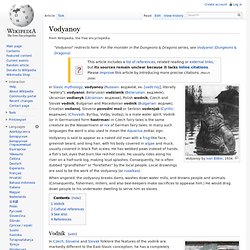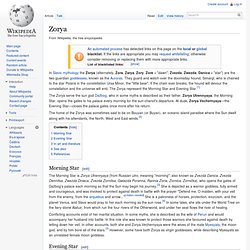

Rusalka. Vodyanoy. Vodyanoy is said to appear as a naked old man with a frog-like face, greenish beard, and long hair, with his body covered in algae and muck, usually covered in black fish scales.

He has webbed paws instead of hands, a fish's tail, eyes that burn like red-hot coals. He usually rides along his river on a half-sunk log, making loud splashes. Consequently, he is often dubbed "grandfather" or "forefather" by the local people. Top 10 Mysterious People. Mysteries Over the centuries, history is filled with wonderful tales of mysterious people – many of whom are never identified.

This list is a selection of the most significant or mysterious people of this variety. As usual, if you know of other fascinating people that would suit a similar follow up list, be sure to tell us in the comments. Monsieur Chouchani (died 1968) is the nickname of an anonymous and mysterious Jewish teacher who taught a number of highly regarded students including Emmanual Levinas (pictured above) and Elie Wiesel in Europe after World War II.
Very little is known about Chouchani, including his real name. There is no known body of work by Chouchani himself, but he left a very strong intellectual legacy via his students. The Poe Toaster is the nickname given to a mysterious man who pays annual tribute to Poe by visiting his grave every year. The Toaster wears a black hat and coat and hides his face with a hood or scarf. Fulcanelli (1839 – ? D. Hecate. Ancient Greek goddess of magic and crossroads Hecate was one of the main deities worshiped in Athenian households as a protective goddess and one who bestowed prosperity and daily blessings on the family.[5] In the post-Christian writings of the Chaldean Oracles (2nd–3rd century CE) she was regarded with (some) rulership over earth, sea, and sky, as well as a more universal role as Savior (Soteira), Mother of Angels and the Cosmic World Soul.[6][7] Regarding the nature of her cult, it has been remarked, "she is more at home on the fringes than in the center of Greek polytheism.

Intrinsically ambivalent and polymorphous, she straddles conventional boundaries and eludes definition. "[8] Name and origin[edit] Aspalis. In Greek mythology, Aspalis (Ἁσπαλίς) was a local heroine from Melite in Phthia whose story was apparently meant to provide an etiology for the local surname and cult of Artemis. As in certain Artemis mythology,[1] she hanged herself and her body disappeared. The exact story of Aspalis, known from Antoninus Liberalis, is as follows.
Melite was once ruled by a tyrant so cruel that the citizens dared not pronounce his real name, dubbing him Tartarus. He would order for the most beautiful girls to be brought to him and made them his concubines against their will. When he sent for Aspalis, daughter of Argaeus, the girl hanged herself rather than be violated. Aspalis was speculated to have originally been a western Semitic hunting goddess identified with Artemis.[3]
Sedna (mythology) Sedna (Inuktitut: ᓴᓐᓇ, Sanna) is the goddess of the sea and marine animals in Inuit mythology, also known as the Mother of the Sea or Mistress of the Sea. The story of Sedna, which is a creation myth, describes how she came to rule over Adlivun, the Inuit underworld. Sedna is also known as Arnakuagsak or Arnaqquassaaq (Greenland) and Sassuma Arnaa ("Mother of the Deep", West Greenland) and Nerrivik ("Table", northern Greenland) or Nuliajuk (District of Keewatin, Northwest Territories, Canada). She is sometimes known by other names by different Inuit groups such as Arnapkapfaaluk ("Big Bad Woman") of the Copper Inuit from the Coronation Gulf area[1] and Takánakapsâluk or Takannaaluk (Igloolik).
More than one version of the Sedna legend exists. Gefjon. Tamar (goddess) Dike (mythology) "Eunomia and that unsullied fountain Dikē, her sister, sure support of cities; and Eirene of the same kin, who are the stewards of wealth for mankind — three glorious daughters of wise-counselled Themis. "[5] She ruled over human justice, while her mother Themis ruled over divine justice.
Her opposite was adikia ("injustice"): in reliefs on the archaic Chest of Cypselus preserved at Olympia,[6] a comely Dikē throttled an ugly Adikia and beat her with a stick. The later art of rhetoric treated the personification of abstract concepts as an artistic device, which devolved into the allegorizing that Late Antiquity bequeathed to patristic literature.
Zorya. The Zorya serve the sun god Dažbog, who in some myths is described as their father.

Zorya Utrennyaya, the Morning Star, opens the gates to his palace every morning for the sun-chariot's departure. At dusk, Zorya Vechernyaya—the Evening Star—closes the palace gates once more after his return. Britomartis. Britomartis (Βριτόμαρτις) was the Minoan goddess of mountains and hunting. She is among the Minoan goddess figures that passed through the Mycenaeans' culture into classical Greek mythology, with transformations that are unclear in both transferrals.[1] For the Greeks Britomartis (Cretan dialect[2] for "sweet maiden", "sweet virgin"[3]) or Diktynna (derived by Hellenistic writers as from diktya, "hunting nets")[4] was a mountain nymph (an oread) whom Greeks recognized also in Artemis and in Aphaea, the "invisible" patroness of Aegina.[5] Every element of the classical myths that told about Britomartis served to reduce her power and scope, even literally to entrap her in nets (but only because she "wanted" to be entrapped).
By Hellenistic and Roman times, Britomartis was given a genealogical setting that fitted her into a Classical context: As Diktynna[edit] Britomartis. In Greek mythology, Britomartis (Βριτόμαρτις , "sweet maid", "good maiden", "sweet virgin") was a nymph (an Oread) also known as Aphaea and Diktynna. She was also associated with Potnia and Artemis.